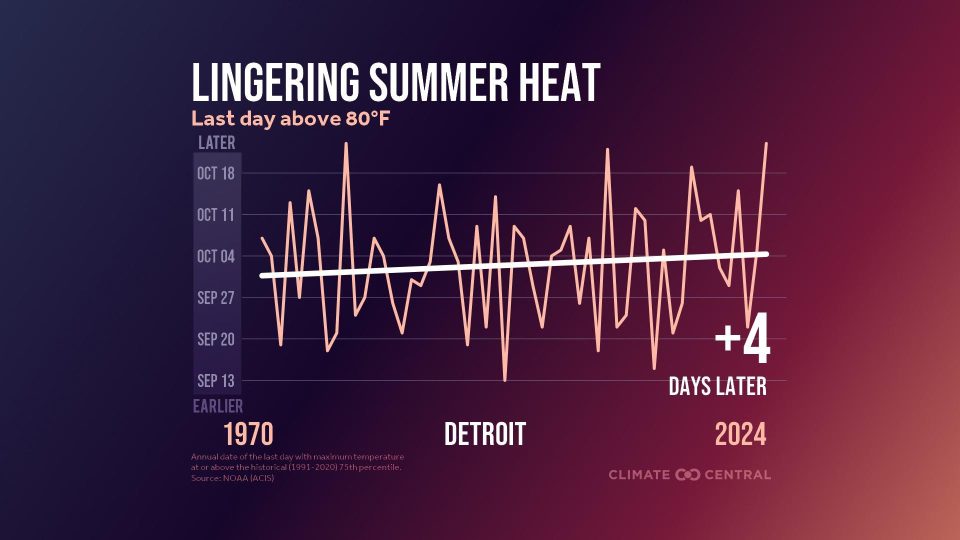By Jim Bloch
Summerlike days with temperature of 80 degrees and higher are lingering longer into the fall than occurred in the 1970s.
That’s the main takeaway from new research by Climate Central, the nonprofit organization that studies the impacts of climate change in the U.S. and the world, published Sept. 5.

“Summer is lingering later in 227 (92%) of the 246 major U.S. cities analyzed,” the report said. “Across these 227 cities, summer temperatures now extend 10 days later into the fall, on average, than in the early 1970s. About one in every five cities now see summer temperatures extend at least two weeks later into the fall.”
The Detroit area has lagged behind the nation, with the last 80-degree day occurring an average of four days than in the late 1970s. But Detroit falls have warmed on average more than the country as a whole.
Climate Central uses the meteorological start of fall, which is Sept. 1.
This year, Detroit saw 14 80-degree days in September, according to weatherandclimate.info. The hottest day of the month was Sept. 18 at 88 degrees.
Along with the lingering heat comes the lingering dangers associated with high heat, such as longer allergy, mosquito and tick seasons, extended wildfire and hurricane seasons and longer reliance on air conditioners, which increases energy demand, which increases the emissions of heating-trapping pollutants.
The main reason? Climate change.
“The hottest days of the year are getting even hotter because of climate change,” the report said. “Recent analysis shows that heat-trapping pollution — mainly from burning coal, oil, and gas — has fueled the rise in summer’s extremely hot days and dangerously warm nights over the last 55 years.”
Burning fossil fuels began in earnest with the coming of the so-called second industrial revolution in the mid-19th Century, emitting gases such as carbon dioxide into the atmosphere, which traps the heat of the sun, warming the planet. Carbon dioxide accounts for about 70 percent of the warming; methane about 25 percent and nitrous oxide about five percent.
Autumns in Detroit are now 3.8 degrees warmer than they were in 1970. That’s significantly warmer than the 2.8-degree average increase in 243 U.S. cities. Nineteen days each fall are now warmer than the 54-year average since 1970.
“Summer heat isn’t just getting more intense due to climate change,” said Shel Winkley, a Climate Central meteorologist in a video statement. “But it’s hanging on longer into the fall season. The places experiencing summer creep the most are Florida and Texas. Take Miami. Summer heat now lingers about a month and a half longer.”
Hot days do more than make you feel sweaty and sticky. Heat is the biggest weather-related killer of people in the U.S., according to the National Weather Center. In 2024, there were 177 heat-related fatalities, outdistancing floods at 145, and hurricanes and rip tides, both at 74. The 30-year average of heat related deaths is 238; the 10-year average is 199. For floods, the 30-year average is 113; the 10-year average is 89. For hurricanes, the 30-year average is 51; the 10-year average is 27. Data were not available for a 30-year average of rip-tide fatalities; the 10-year average was 75.
“Research shows and tells us that if heat-trapping pollution keeps rising, summer temperatures will keep stretching later and later,” said Winkley. “Climate change is turning sweater weather into a longer short-sleeve season.”
Jim Bloch is a freelance writer based in St. Clair, Michigan. Contact him at bloch.jim@gmail.com.



